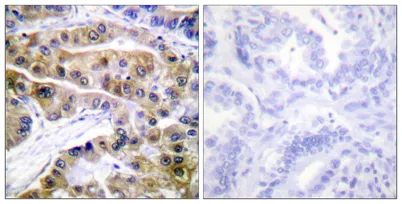Na+/K+-ATPase α1 (phospho Ser16) rabbit pAb
CAT:
855-ES6359-01
Size:
50 μL
Price:
Ask
- Availability: 24/48H Stock Items & 2 to 6 Weeks non Stock Items.
- Dry Ice Shipment: No




Na+/K+-ATPase α1 (phospho Ser16) rabbit pAb
- Description: The protein encoded by this gene belongs to the family of P-type cation transport ATPases, and to the subfamily of Na+/K+ -ATPases. Na+/K+ -ATPase is an integral membrane protein responsible for establishing and maintaining the electrochemical gradients of Na and K ions across the plasma membrane. These gradients are essential for osmoregulation, for sodium-coupled transport of a variety of organic and inorganic molecules, and for electrical excitability of nerve and muscle. This enzyme is composed of two subunits, a large catalytic subunit (alpha) and a smaller glycoprotein subunit (beta). The catalytic subunit of Na+/K+ -ATPase is encoded by multiple genes. This gene encodes an alpha 1 subunit. Multiple transcript variants encoding different isoforms have been found for this gene. [provided by RefSeq, May 2009],
- Synonyms: ATP1A1; Sodium/potassium-transporting ATPase subunit alpha-1; Na(+)/K(+) ATPase alpha-1 subunit; Sodium pump subunit alpha-1
- Gene ID: 476
- UniProt: P05023
- Cellular Locus: Basolateral cell membrane ; Multi-pass membrane protein. Cell membrane, sarcolemma ; Multi-pass membrane protein. Cell projection, axon. Melanosome. Identified by mass spectrometry in melanosome fractions from stage I to stage IV..
- Host: Rabbit
- Species Reactivity: Human, Mouse, Rat
- Immunogen: The antiserum was produced against synthesized peptide derived from human ATPase around the phosphorylation site of Ser16. AA range:5-54
- Clonality: Polyclonal
- Validated Applications: WB, IHC, IF, ELISA
- Stability: 1 year
- Concentration: 1 mg/mL
- Dilution: Western Blot: 1/500 - 1/2000. Immunohistochemistry: 1/100 - 1/300. ELISA: 1/5000. Not yet tested in other applications.
- Molecular Weight: 112kD
- Storage Conditions: PBS with 0.02% sodium azide and 50% glycerol pH 7.4. Store at -20°C. Avoid repeated freeze-thaw cycles.
